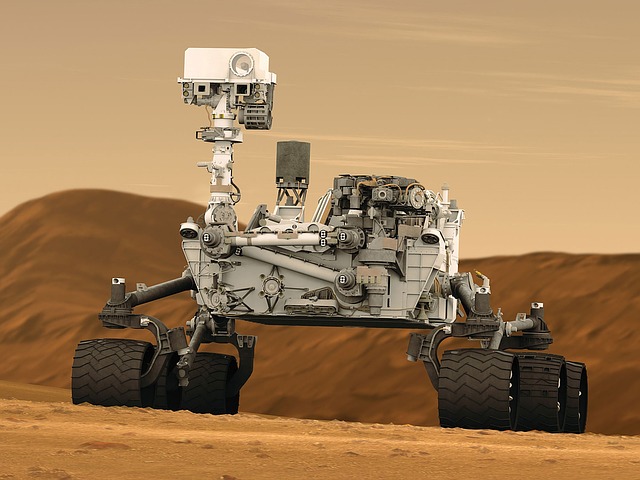
Venus – also known as the evening and morning star – is the most interesting among our neighboring planets within the solar system. In fact, Venus is the third-brightest object in the sky, after the sun and moon.
And yet, it’s planet Mars which gets frequently featured in sci-fi movies and TV shows.
So, what’s the attraction?
Unlike Venus, which is brilliant and fiery, Mars is a very cold planet. It is also only about half the size of Earth with gravity that’s just one-third of our own.
Ironically, it’s Mars which is called the Red Planet, when that color of love and passion should have belonged to Venus which was named after the goddess of love and beauty.
But then, Mars is called that way because it appears red due to its iron-rich soil. Although this fourth, rocky planet from the sun is characterized by canyons, craters, and volcanoes, it is largely covered with red dust. Red dust that can turn into great dust storms when the winds blow with immense strength, enough to create red-colored tornadoes covering the entire planet.
How important is Mars to mankind?
Well, it had been worshipped in ancient times like in Babylon. Babylonians associated this red planet with their war-god Nergal due to its bloody color. In so much the same way, the Greeks named this fascinating planet after their god of war, Ares. The Romans followed suit and honored Mars with the name of their god of war.
Today, we are more interested in Mars in a scientific way. After all, it may be the only other planet where life exists — or had existed.
The National Aeronautics and Space Administration (NASA) has been exploring Mars since 1965. Mariner 4 was the first NASA spacecraft to have a close look at this red planet. Then, in 1976, NASA sent spacecrafts Viking 1 and Viking 2 to Mars. After landing, pictures were taken and the planet’s rocky, dusty surface was explored. From then on, more spacecrafts have been sent either to fly near or land on Mars for deeper studies.
However, it was in January 2004 that NASA made their most exciting discovery about Mars! The rovers Spirit and Opportunity found evidence that water once flowed on the red planet. If there was water, then the existence of some type of life forms must have been a real possibility.
Researchers started to theorize that life might have evolved on Mars during the period when it was still wet, and that there could still be some living things that are hidden in the planet’s subterranean aquifers.
“On Earth, water means life,” explained Alberto Fairen, an astrobiologist at the Center of Astrobiology in Spain and Cornell University in Ithaca, New York. “The surface of Mars today is extremely dry, but there are lots of clues pointing to a much wetter past. Evidence for past water may be the clue to follow to find extinct life on Mars and if some of that water still persists on Mars today, then for sure the prospects to find extant life go up.”
Is there really life on Mars?
From the Red Planet’s water discovery, the world’s attention now also turns to boron – an element that when dissolved in water becomes a borate, and it turn can catalyze the formation of ribonucleic acid (RNA).
In a paper published on Geophysical Research Letters, the team of lead author Patrick Gasda, a postdoctoral researcher at Los Alamos National Laboratory in Los Alamos, New Mexico, reported that NASA Curiosity rover ChemCam instrument has detected boron in the 3.8 billion year old Gale crater.
“Because borates may play an important role in making RNA—one of the building blocks of life—finding boron on Mars further opens the possibility that life could have once arisen on the planet,” Gasda stated, adding that “Borates are one possible bridge from simple organic molecules to RNA. Without RNA, you have no life. The presence of boron tells us that, if organics were present on Mars, these chemical reactions could have occurred. Essentially, this tells us that the conditions from which life could have potentially grown may have existed on ancient Mars, independent from Earth.”
This is something that people all over the world, not only movies and TV shows, would love to be proven true. We have been wondering about extraterrestrial beings and UFO’s for so long. If there is, or there had been life on Mars, what would they look like?
And even if there’s none, does the presence of water and essential minerals on Mars mean it could really be colonized?
NASA intends to send a human mission to Mars in the near future. Maybe this time they will find the answer, which in the words of Tesla and SpaceX CEO Elon Musk, will lead to mankind finally becoming a multi-planetary species. And when that time comes, the courage of our astronauts and visionaries who explore the unknown will be rewarded with the biggest discovery of all!
- Bulenox: Get 45% to 91% OFF ... Use Discount Code: UNO
- Risk Our Money Not Yours | Get 50% to 90% OFF ... Use Discount Code: MMBVBKSM
Disclaimer: This page contains affiliate links. If you choose to make a purchase after clicking a link, we may receive a commission at no additional cost to you. Thank you for your support!




Leave a Reply